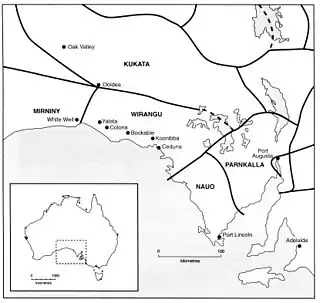Nukunu language
Nukunu (or Nugunu or many other names: see below) is a moribund Australian Aboriginal language spoken by Nukunu people on Yorke Peninsula, South Australia. As of 2017, there is a revival and maintenance programme under way for the language.[2]
| Nukunu | |
|---|---|
| Region | South Australia |
| Ethnicity | Nukunu |
| Extinct | ca. 2000 |
Pama–Nyungan
| |
| Latin | |
| Language codes | |
| ISO 639-3 | nnv |
| Glottolog | nugu1241 |
| AIATSIS[1] | L4 |
| ELP | Nukunu |
Names
This language has been known by many names by neighbouring tribes and Australianists, including:
- Nukuna, Nokunna, Noocoona, Nookoona, Nuguna, Nukana, Nukunnu, Nukunu, Njuguna
- Doora
- Pukunna
- Tjura, Tyura
- Wallaroo, Warra
- Wongaidya (from wangkatya, present tense form of verb 'to speak')
Classification
Nukunu is a Pama–Nyungan language, closely related to neighboring languages in the Miru cluster[3] like Narungga, Kaurna, and Ngadjuri.
Phonology
Vowels
Nukunu has three different vowels with contrastive long and short lengths (a, i, u, a:, i:, u:).
| Front | Back | |
|---|---|---|
| High | i iː | u uː |
| Low | a aː | |
Consonants
The Nukunu consonantal inventory is typical for a Pama–Nyungan language, with six places of articulation for stops and nasals. There are three rhotics in the language.
| Peripheral | Laminal | Apical | |||||
|---|---|---|---|---|---|---|---|
| Labial | Velar | Dental | Palatal | Alveolar | Retroflex | ||
| Stop | Voiceless | p | k | t̪ | c | t | ʈ |
| Voiced | (ɖ) | ||||||
| Nasal | m | ŋ | n̪ | ɲ | n | ɳ | |
| Lateral | l̪ | ʎ | l | ɭ | |||
| Tap | ɾ | ||||||
| Trill | r | ||||||
| Approximant | w | j | ɻ | ||||
A phonemic voicing contrast exists in Nukunu, but it has only been observed in the retroflex stop series. An example demonstrating such a contrast intervocalically is kurdi (phlegm, IPA ['kuɖi]) and kurti (quandong, IPA ['kuʈi]).
History
In contrast with other Thura–Yura languages, Nukunu did not partake in either the initial th- lenition before vowels or the lenition of initial k- before vowels.
Notes
- L4 Nukunu at the Australian Indigenous Languages Database, Australian Institute of Aboriginal and Torres Strait Islander Studies
- Monaghan, Paul (2017). "1. Structures of Aboriginal life at the time of colonisation in South Australia". In Brock, Peggy; Gara, Tom (eds.). Colonialism and its aftermath: A history of Aboriginal South Australia (PDF). Extract, pp.i-xxiii. Wakefield. p. 17. ISBN 9781743054994.
- Hercus pp. 1; Schmidt called this cluster (a subgroup of Thura–Yura) as "Miru" in 1919. Perhaps these languages are part of the Kadli group as well.
References
- Hercus, Luise Anna (1992). "Introduction". A Nukunu Dictionary. Maitland, South Australia: National Library of Australia Cataloguing-in-Publication entry.
